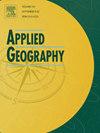How do water quality requirements and spatial flows shape the supply-demand balance of water provision ecosystem services? Evidence from the Taihu Lake Basin
IF 4
2区 地球科学
Q1 GEOGRAPHY
引用次数: 0
Abstract
Water provision ecosystem services (WES) underpin regional geographical sustainability, with their spatial supply–demand balance essential for adaptive resource management. Previous studies overlooked water quality heterogeneity and cross–regional WES flows (WESFs), leading to misdiagnoses of supply–demand patterns. We integrated sector-specific water quality requirements and WESFs into a spatially refined assessment framework through geospatial analysis, constructing a social-ecological network for the Taihu Lake Basin (491 subbasins). Results revealed persistent spatial mismatches despite overall sufficient supply. Western areas maintained supply–demand balance due to ample headwaters and intact upstream connectivity, while eastern areas experienced imbalances from urbanization and disrupted flow pathways. Key drivers included industrial water intensity, insufficient high–quality water, and reduced upstream inflows, resulting in a 19.72 % decline in WESF volumes and balance–to–imbalance shifts in 30 subbasins. We propose ecological compensation, quality-based regulation, and WESF restoration to improve water resource management, emphasizing incorporating spatial water quality constraints and flow dynamics into WES assessments for targeted geographic interventions.

水质要求和空间流动如何影响供水生态系统服务的供需平衡?来自太湖盆地的证据
供水生态系统服务(WES)是区域地理可持续性的基础,其空间供需平衡对适应性资源管理至关重要。以往的研究忽略了水质异质性和跨区域WES流量,导致供需模式的误诊。通过地理空间分析,将各行业的水质需求和wesf整合到一个空间精细化的评价框架中,构建了太湖流域(491个子流域)的社会生态网络。结果显示,尽管总体供应充足,但空间不匹配仍然存在。西部地区因源头充足、上游连通完整而保持供需平衡,而东部地区则因城市化和流动路径中断而出现供需失衡。主要驱动因素包括工业用水强度、优质水不足和上游流入减少,导致WESF量下降19.72%,30个子流域出现平衡-不平衡转变。我们提出了生态补偿、基于质量的调节和WESF恢复来改善水资源管理,强调将空间水质约束和流动动力学纳入WESF评估,以进行有针对性的地理干预。
本文章由计算机程序翻译,如有差异,请以英文原文为准。
求助全文
约1分钟内获得全文
求助全文
来源期刊

Applied Geography
GEOGRAPHY-
CiteScore
8.00
自引率
2.00%
发文量
134
期刊介绍:
Applied Geography is a journal devoted to the publication of research which utilizes geographic approaches (human, physical, nature-society and GIScience) to resolve human problems that have a spatial dimension. These problems may be related to the assessment, management and allocation of the world physical and/or human resources. The underlying rationale of the journal is that only through a clear understanding of the relevant societal, physical, and coupled natural-humans systems can we resolve such problems. Papers are invited on any theme involving the application of geographical theory and methodology in the resolution of human problems.
 求助内容:
求助内容: 应助结果提醒方式:
应助结果提醒方式:


